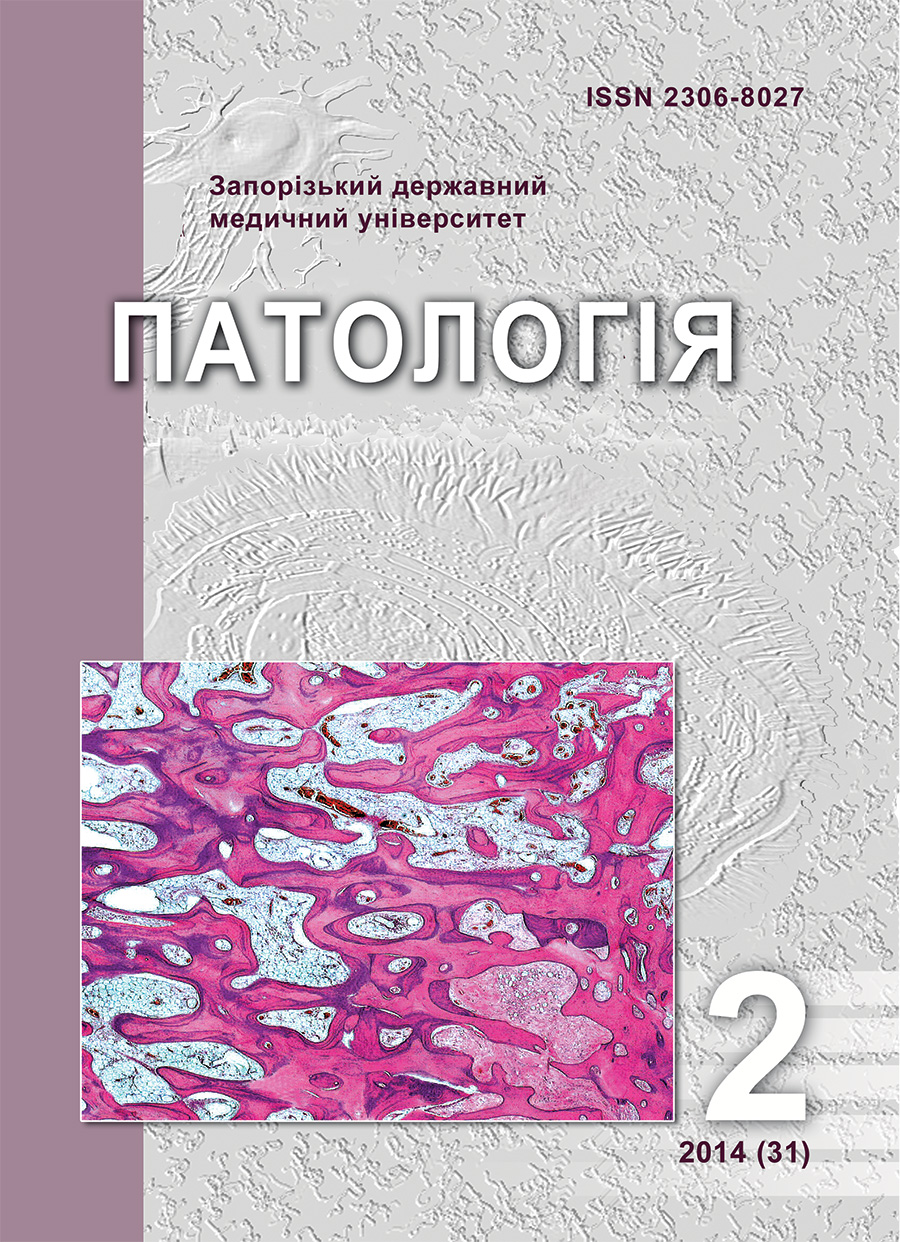Influence of chronic prenatal hypoxia on the specialized contact apparatus of rat heart ventricles during ontogeny
DOI:
https://doi.org/10.14739/2310-1237.2014.2.28550Keywords:
Ventricular Myocardium, Rats, Intercellular Junction, Fetal Hypoxia, GrowthAbstract
Background. During prenatal development embryonic mammalian heart undergoes deep dynamic changes due to size, structure and functions. Pathological intrauterine hypoxia influences fetal development generally and cardiogeny particularly, it affects the structure and function of the heart muscle and can lead to a variety of cardiovascular abnormalities and congenital heart defects. It is known that as a result of chronic intrauterine hypoxia during the stages of prenatal ontogeny specialized intercellular apparatus of cardiomyocytes is damaged, which plays a role not only in the mechanical connections of the cardiomyocytes, but also in the electric cooperatives, metabolic conversions, the homeostasis of the ionic balance and transport morphogenetic signaling molecules which are involved into the mechanisms of cardiogeny. It contributes to the development of diseases that may be associated with impaired local distribution of specialized intercellular junctions, and manifests as arrhythmias and cardiac conduction.
Objective. To determine the effects of chronic prenatal hypoxia on the structure and distribution of specialized intercellular junctions of typical cardiomyocytes in the rat ventricular myocardium at the stages of prenatal ontogeny and to evaluate morphometric parameters of intercalated disks in the postnatal period.
Materials and methods. White rats were used as a material. Intrauterine hypoxia was modelled by intraperitoneal injection of sodium nitrite from 10th to 21st day of pregnancy. Hearts were investigated by the transmission electron microscopy during the stages of prenatal and postnatal ontogeny and in adult animals. Morphometric and statistical methods were applied. Pairwise comparisons between means of different groups were performed using Student’s t-test where, for each couple of normally distributed populations, the null hypothesis that the means are equal was verified.
Results. The average length of desmosomes on the 20th day of embryogenesis is lower in experimental group by 31,3% (p <0,05) in the left ventricle and 30,8% (p <0,05) in the right ventricle than parameters in the control group. The slowdown of growth of the profile length density of fascia adhaerens in the myocardium increases on the 20th day of cardiogeny and it was lower by 32,9% (p <0,05) in the left ventricle and 37,3% (p <0,05) in the right ventricle as compared with the control. During normal prenatal cardiogeny ventricular level of communicative contacts in cardiomyocytes respectably increases and shows a significant increase in nexus mean length from 14th to 18th day of embryogenesis by 75,5% in the control and insignificant increase in the left ventricle in experimental group – 23,6%. The increase in value of the convolution index of intercalated disc of rats with hypoxic myocardial damage as compared with the corresponding value in the neonatal period was 85,4% (p <0,05) in the left ventricle and 52,3% (p <0,05) in the right ventricle.
Conclusion. It was established that the alterative influence of intrauterine hypoxia factor is associated with the formation delay of the mechanical and electrical contacts between the contractive cardiomyocytes of the left and right ventricles of rat heart at the stages of prenatal ontogeny. The increasing complexity of the geometry of the intercalated disc is characterized by slower growth of convolution index.
References
Patterson, A. J., & Zhang, L. (2010). Hypoxia and fetal heart development. Curr. Mol. Med., 10(7), 653–666.
Zadnipryanyj, I. V., & Tret'yakova, O. S. (2011). Strukturnaya perestrojka miokarda pri perinatal'noj gipoksii v usloviyakh e`ksperimenta [Structural reorganization of the myocardium at perinatal hypoxia in experimental conditions]. Krymskij zhurnal e`ksperimental'noj i klinicheskoj mediciny, 1(1), 40–45. [in Ukrainian].
Ivanickaya, N. F. (1976) Metodika polucheniya raznykh stadij gemicheskoj gipoksii u krys vvedeniem nitrita natriya [Method of producing different stages of hemic hypoxia in rats by sodium nitrite administration]. Patologicheskaya fiziologiya i e`ksperimental'naya terapiya, 3, 69–71. [in Russian].
Collins, T. J. (2007). ImageJ for microscopy. BioTechniques., 43, 25–30.
Petruk, N. S. (2013) Ul'trastrukturna kharakterystyka mekhanіzmu formuvannia ta rozvytku vstavnogo dyska v robochomu mіokardі shlunochkіv shchurіv na etapakh postnatalnoho ontohenezu [Ultrastructural characteristics of the formation and development of the intercalated disc in the rat left and right working ventricular myocardium on the postnatal ontogenetic stages]. Morpholohiia, 7(3), 94–100. [in Ukrainian].
Gourdie, R. G., Green, C. R., Severs, N. J., & Thompson, R. P. (1992) Immunolabelling patterns of gap junction connexins in the developing and mature rat heart. Anatomy and Embryology, 185(4), 363–378. doi: 10.1007/BF00188548.
Downloads
How to Cite
Issue
Section
License
Authors who publish with this journal agree to the following terms:- Authors retain copyright and grant the journal right of first publication with the work simultaneously licensed under a Creative Commons Attribution License that allows others to share the work with an acknowledgement of the work's authorship and initial publication in this journal.

- Authors are able to enter into separate, additional contractual arrangements for the non-exclusive distribution of the journal's published version of the work (e.g., post it to an institutional repository or publish it in a book), with an acknowledgement of its initial publication in this journal.
- Authors are permitted and encouraged to post their work online (e.g., in institutional repositories or on their website) prior to and during the submission process, as it can lead to productive exchanges, as well as earlier and greater citation of published work (SeeThe Effect of Open Access).

